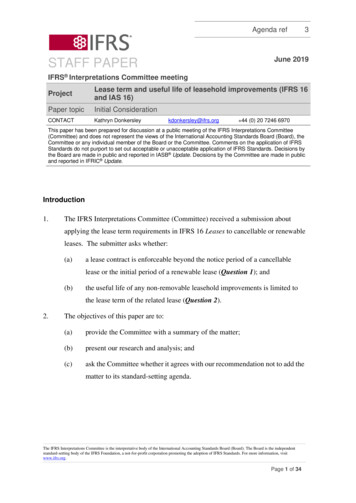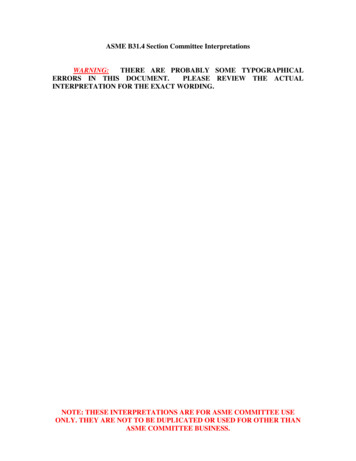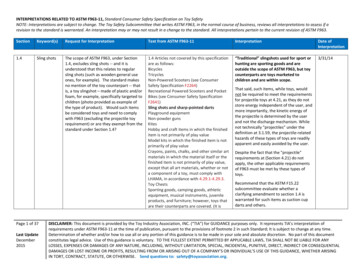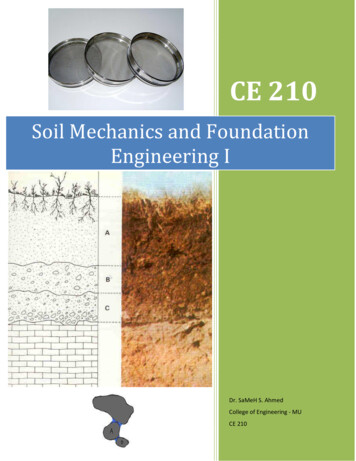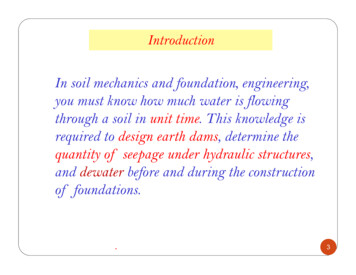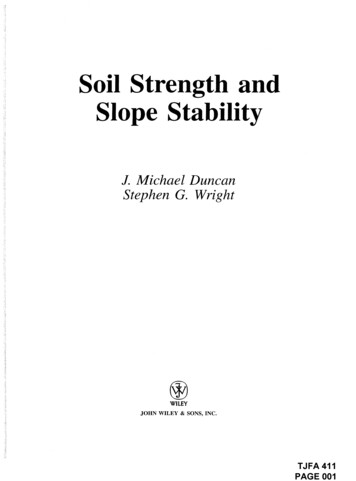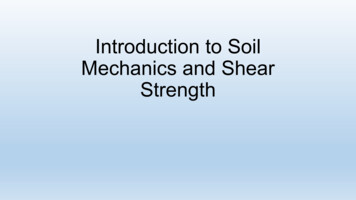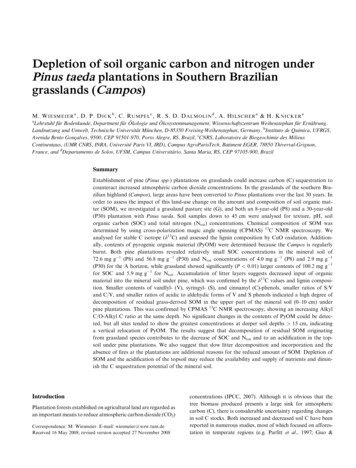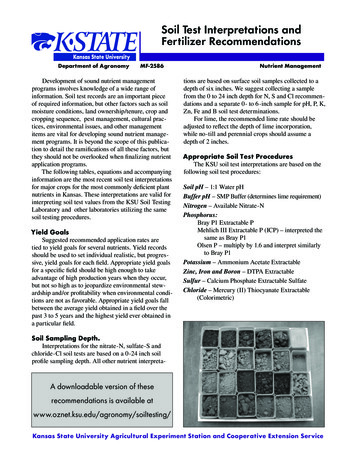
Transcription
Soil Test Interpretations andFertilizer RecommendationsDepartment of AgronomyMF-2586Development of sound nutrient managementprograms involves knowledge of a wide range ofinformation. Soil test records are an important pieceof required information, but other factors such as soilmoisture conditions, land ownership/tenure, crop andcropping sequence, pest management, cultural practices, environmental issues, and other managementitems are vital for developing sound nutrient management programs. It is beyond the scope of this publication to detail the ramifications of all these factors, butthey should not be overlooked when finalizing nutrientapplication programs.The following tables, equations and accompanyinginformation are the most recent soil test interpretationsfor major crops for the most commonly deficient plantnutrients in Kansas. These interpretations are valid forinterpreting soil test values from the KSU Soil TestingLaboratory and other laboratories utilizing the samesoil testing procedures.Yield GoalsSuggested recommended application rates aretied to yield goals for several nutrients. Yield recordsshould be used to set individual realistic, but progressive, yield goals for each field. Appropriate yield goalsfor a specific field should be high enough to takeadvantage of high production years when they occur,but not so high as to jeopardize environmental stewardship and/or profitability when environmental conditions are not as favorable. Appropriate yield goals fallbetween the average yield obtained in a field over thepast 3 to 5 years and the highest yield ever obtained ina particular field.Nutrient Managementtions are based on surface soil samples collected to adepth of six inches. We suggest collecting a samplefrom the 0 to 24 inch depth for N, S and Cl recommendations and a separate 0- to 6-inch sample for pH, P, K,Zn, Fe and B soil test determinations.For lime, the recommended lime rate should beadjusted to reflect the depth of lime incorporation,while no-till and perennial crops should assume adepth of 2 inches.Appropriate Soil Test ProceduresThe KSU soil test interpretations are based on thefollowing soil test procedures:Soil pH – 1:1 Water pHBuffer pH – SMP Buffer (determines lime requirement)Nitrogen – Available Nitrate-NPhosphorus:Bray P1 Extractable PMehlich III Extractable P (ICP) – interpreted thesame as Bray P1Olsen P – multiply by 1.6 and interpret similarlyto Bray P1Potassium – Ammonium Acetate ExtractableZinc, Iron and Boron – DTPA ExtractableSulfur – Calcium Phosphate Extractable SulfateChloride – Mercury (II) Thiocyanate Extractable(Colorimetric)Soil Sampling Depth.Interpretations for the nitrate-N, sulfate-S andchloride-Cl soil tests are based on a 0-24 inch soilprofile sampling depth. All other nutrient interpreta-A downloadable version of theserecommendations is available atwww.oznet.ksu.edu/agronomy/soiltesting/Kansas State University Agricultural Experiment Station and Cooperative Extension Service
Soil pH and Liming InterpretationsA buffer pH will be determined and reported onall soils having a pH of less then 6.4. Options are provided for liming to various target pH’s and information is provided for various areas of the state to aid inselection of an appropriate target pH, based on subsoilacidity and crops to be grown.Phosphorus and PotassiumInterpretations.Kansas State University phosphorus and potassium recommendations provide two main options forproducers, depending on circumstances for specificproducers, fields and situations.‘Sufficiency’ fertility programs are intended to estimate the long-term average amount of fertilizer phosphorus required to, on the average, provide optimumeconomic return in the year of nutrient applicationwhile achieving about 90 to 95 percent of maximumyield. In some years greater amounts of nutrient arerequired for optimum yield and economic return,while in other years less than recommended amountsof nutrient would suffice. There is little considerationof future soil test values and soil test values will likelystabilize in the ‘low’, crop responsive range.‘Build-maintenance’ recommendations areintended to apply enough phosphorus or potassium tobuild soil test values to a target soil test value over aplanned timeframe (typically 4 to 8 years) and thenmaintain soil test values in a target range in futureyears. If soil test values exceed the target range, nophosphorus or potassium is recommended with theexception of low starter applied rates if desired. Buildmaintenance fertility programs are not intended toprovide optimum economic returns in a given year, butrather attempt to minimize the probability of phosphorus or potassium limiting crop yields while providingfor near maximum yield potential.Nitrogen InterpretationsThe nitrogen requirement for a specific crop andyield goal is adjusted by taking into account many fieldspecific factors. The K-State nitrogen recommendationguidelines for all crops are directly adjusted for soilorganic matter content. Twenty pounds of availableN per acre is expected to be mineralized during thecrop year for each 1.0 percent soil organic matter inthe surface six inches for warm season crops (e.g. corn,grain sorghum), while 10 pounds nitrogen per acre isexpected to be mineralized for each 1.0 percent soilorganic matter for cool season crops (e.g. wheat). Inaddition, the previous crop, residual profile N, manureapplications, irrigation water N content, grazing Nremoval and the tillage system utilized are additionalfactors used to refine suggested N application rates forspecific crop situations. Detailed information for majorcrops is provided. Since nitrate (NO3 - -N) is mobile,we encourage use of a 0- to 24-inch soil sample toassess the profile N content (also for sulfate and chloride as they are mobile in soils as well).How and when N is applied can have a dramaticeffect on how efficiently it will be utilized by the crop.For example, using delayed or split N applicationson irrigated fields, particularly on sandy soils, oftenimproves N use efficiency by reducing the potentialfor loss. Also, for high residue systems such as no-till,placing fertilizer N below the residue or dribblingN solution in concentrated bands on the soil surfaceoffers the potential for improved N use efficiency forsummer crops. Many factors other than applicationrate influence N use efficiency and should be takeninto account when developing the overall nutrientmanagement plan.Secondary/Micronutrient InterpretationsThe KSU Soil Testing Lab offers soil tests andinterpretations for sulfur, zinc, chloride, iron andboron. Detailed information is provided for interpreting soil test values for these nutrients and for recommending rates of application if they are deficient. Todate in Kansas, we have not documented deficienciesof manganese (Mn), copper (Cu), or molybdenum(Mo) and do not offer interpretations for these micronutrients.2
Nitrogen Rate Recommendation Adjustmentsfor Cool Season CropsNitrogen Rate Recommendation Adjustmentsfor Warm Season CropsSoil Organic Matter (SOM) AdjustmentLb N/A Adjustment % SOM x 10Soil Organic Matter (SOM) AdjustmentLb N/A Adjustment % SOM x 20Manure NInorganic NOrganic N100% of Manure Worksheet value250% of Manure Worksheet value2Manure NInorganic NOrganic N100% of Manure Worksheet value2100% of Manure Worksheet value2Profile N Test (2 foot sampling depth , if possible)Default30 Lb N/A if Profile N Sample Not CollectedLb N/A 0.3 x Sampling Depth (inches) x ppm Profile Nitrate-NProfile N Test (2 foot sampling depth , if possible)Default30 Lb N/A if Profile N Sample Not CollectedLb N/A 0.3 x Sampling Depth (inches) x ppm Profile Nitrate-NTillage AdjustmentConventional TillageNo-TillageIrrigation Water Nitrate NLb N/A ppm Nitrate-N in Water x 0.226 x Inches Irrigation Water Applied0 Lb N/A 20 Lb N/AGrazing Adjustment40 Lb N per 100 Lb beef weight gain per acre3Previous Crop AdjustmentCorn, WheatPrevious Crop AdjustmentCorn, Wheat0 Lb N/ASorghum, Sunflowers0 Lb N/ASorghum, Sunflowers, 30 Lb N/ASoybeansFallowWithout Profile N TestWith Profile N Test- 20 Lb N/A0 Lb N/AWith StandDestruction Tillage1- 20 Lb N/A0 Lb N/AAlfalfaExcellent Stand ( 5 plants/ft2)Good Stand (2 – 5 plants/ft2)Fair Stand (1-2 plants/ft2)Poor Stand ( 1 plant/ft2)With StandDestruction Tillage1- 120- 80- 400Lb N/ALb N/ALb N/ALb N/AAlfalfaExcellent Stand ( 5 plants/ft2)Good Stand (2 – 5 plants/ft2)Fair Stand (1-2 plants/ft2)Poor Stand ( 1 plant/ft2)- 60- 40- 200Lb N/ALb N/ALb N/ALb N/ARed CloverExcellent StandGood StandPoor Stand- 80 Lb N/A- 40 Lb N/A0 Lb N/ARed CloverExcellent StandGood StandPoor Stand- 40 Lb N/A- 20 Lb N/A0 Lb N/ASweet CloverExcellent StandGood StandPoor Stand- 110 Lb N/A- 60 Lb N/A0 Lb N/ASweet CloverExcellent StandGood StandPoor Stand2- 40 Lb N/A0 Lb N/AFallowWithout Profile N TestWith Profile N Test1Soybeans0 Lb N/A1- 55 Lb N/A- 30 Lb N/A0 Lb N/AFor no-till production, reduce nitrogen credit adjustment by 50 percent"Estimating Manure Nutrient Availability," MF-25622For no-till production, reduce nitrogen credit adjustment by 50 percent"Estimating Manure Nutrient Availability," MF-2562
Nitrogen RecommendationsCorn Nitrogen RecommendationsFertilizer N Required At Various Yield and Soil Organic Matter Levels Assuming Profile N TestIs Not Used (includes 30 Lb N/A residual default) 1Soil Organic Matter Content 0292282272262252242602.02.53.03.54.000- – – – – – – Lb N/A – – – – – – – –26166N Rec 2, 3 (Yield Goal 1.6) — (% SOM 20) — Profile N — Manure N — Other N Adjustments Previous Crop Adjustments123Total N requirements presented include only Yield Goal and Soil Organic Matter Adjustments assuming profile N test not used. N rate should also be adjusted forPrevious Crop, Manure and Other Appropriate N Rate Adjustments (see N rate adjustments for warm-season crops).Maximum fertilizer N recommendations are 230 Lb N/A for Dryland Corn production and 300 Lb N/A for Irrigated Corn production.A minimum fertilizer N application of 30 Lb N/A may be appropriate for early crop growth and development.Grain Sorghum Nitrogen RecommendationsFertilizer N Required At Various Yield and Soil Organic Matter Levels Assuming Profile N TestIs Not Used (includes 30 Lb N/A residual default) 1Soil Organic Matter Content (%)YieldGoal(Bu/A)1.01.52.02.53.03.54.0– – – – – – – Lb N/A – – – – – – – 2160206196186176166156146200270260250240230220210N Rec (Yield Goal 1.6) – (% SOM 20) – Profile N – Manure N – Other N Adjustments Previous Crop Adjustments212Total N requirements presented include only Yield Goal and Soil Organic Matter Adjustments assuming profile N test not used. N rate should also be adjusted forPrevious Crop, Manure and Other Appropriate N Rate Adjustments (see N rate adjustments for warm-season crops).A minimum fertilizer N application of 30 Lb N/A may be appropriate for early crop growth and development.Wheat Nitrogen RecommendationsFertilizer N Required At Various Yield and Soil Organic Matter Levels Assuming Profile N TestIs Not Used (includes 30 Lb N/A residual default) 1Soil Organic Matter Content (%)YieldGoal(Bu/A)1.01.52.02.53.03.54.0– – – – – – – Lb N/A – – – – – – – 01049994898479747012812311811310810398N Rec2 (Yield Goal 2.4) – (% SOM 10) – Profile N – Other N Adjustments Previous Crop Adjustments Tillage Adjustments Grazing Adjustments12Total N requirements presented include only Yield Goal and Soil Organic Matter Adjustments assuming profile N test not used. N rate should also be adjusted forPrevious Crop, Tillage, Grazing and Other Appropriate N Rate Adjustments (see N rate adjustments for cool-season crops).A minimum fertilizer N application of 30 Lb N/A may be appropriate for early crop growth and development.4
Sunflower Nitrogen RecommendationsFertilizer N Required At Various Yield and Soil Organic Matter Levels Assuming Profile NTest Is Not Used (includes 30 Lb N/A residual default)1Soil Organic Matter Content 3231338070605040118108988878145135125115– – – – – – – Lb N/A – – – – – – – –N Rec 2 (Yield Goal 0.075) – (% SOM 20) – Profile N – Manure N – Other N Adjustments Previous Crop Adjustments12Total N requirements presented include only Yield Goal and Soil Organic Matter Adjustments assuming profile N test not used. N rate should also be adjusted forPrevious Crop, Manure and Other Appropriate N Rate Adjustments (see N rate adjustments for warm-season crops).A minimum fertilizer N application of 30 Lb N/A may be appropriate for early crop growth and development.Oats Nitrogen RecommendationsFertilizer N Required At Various Yield and Soil Organic Matter Levels Assuming Profile N TestIs Not Used (includes 30 Lb N/A residual default)1Soil Organic Matter Content 03.54.01813849443934– – – – – – – Lb N/A – – – – – – – 132127122117112N Rec2 (Yield Goal 1.3) – (% SOM 10) – Profile N – Other N Adjustments Previous Crop Adjustments Tillage Adj12Total N requirements presented include only Yield Goal and Soil Organic Matter Adjustments assuming profile N test not used. N rate should also be adjusted forPrevious Crop, Tillage, Grazing and Other Appropriate N Rate Adjustments (see N rate adjustments for cool-season crops).A minimum fertilizer N application of 30 Lb N/A may be appropriate for early crop growth and development.Corn/Sorghum Silage Nitrogen RecommendationsFertilizer N Required At Various Yield and Soil Organic Matter Levels Assuming Profile N TestIs Not Used (includes 30 Lb N/A residual default)1Soil Organic Matter Content 0803.03.54.01770706050– – – – – – – Lb N/A – – – – – – – 0270260250240230220210N Rec2, 3 (Yield Goal 10.67) – (% SOM 20) – Profile N – Manure N – Other N Adjustments Previous Crop Adjustments123Total N requirements presented include only Yield Goal and Soil Organic Matter Adjustments assuming profile N test not used. N rate should also be adjusted forPrevious Crop, Manure and Other Appropriate N Rate Adjustments (see N rate adjustments for warm-season crops).Maximum fertilizer N recommendations are 230 Lb N/A for Dryland Corn production and 300 Lb N/A for Irrigated Corn production.A minimum fertilizer N application of 30 Lb N/A may be appropriate for early crop growth and development.5
Brome, Fescue and Bermuda Grass Nitrogen RecommendationsN Required At Various Yield Goals11YieldGoal(Ton/A)Production(Lb N/A)NewSeeding(Lb N/A)280204160206240208320201040020Total N requirements presented only include Yield Goal Adjustments. These Total N requirements should be modified for other appropriate adjustments.Liming RecommendationsLime Recommendations (Lb ECC/A)1Buffer pHTarget pH 6.8Target pH 6.0-–––7.412––0lb ECC/acreTarget pH 28,2504,1252,0006.010,250 05.418,000 29,0004,5005.220,000 210,375 25,250Based on 6.67 inch soil depth. Soil Depth is the depth of incorporation through rotation. For No-Till systems, alfalfa and grass – assume 2 inch depth ofincorporation ( 1/3 of rate for 6-7 inch depth).When lime recommendation exceeds 10,000 lb ECC/A, we suggest applying one-half rate, incorporate, wait 12 to 18 months and then retest.Target pH of 6.8 [ 25,620 – (6,360 Buffer pH) (Buffer pH Buffer pH 391)] Depth (inches)All crops in Southeast Kansas – east of Flinthills & south of Highway 56Alfalfa and clover in Northeast KansasLime Rec if pH 6.4Target pH of 6.0 [12,810 – (3,180 Buffer pH) (Buffer pH Buffer pH 196)] Depth (inches)All crops in Northeast Kansas except alfalfa and cloverAll crops in Central and Western KansasLime Rec if pH 5.8Target pH of 5.5 [6,405 – (1,590 Buffer pH) (Buffer pH Buffer pH 98)] Depth (inches)Cash flow/lime availability problem areas in Central and Western KansasLime Rec if pH 5.56
Phosphorus and Potassium RecomendationsPhosphorus and Potassium Crop Removal ValuesCropUnitP2O5K2OAlfalfa & escue, tallton12400.330.26Cornbushelton3.208.70Grain sorghumCorn silagebushel0.400.26Sorghum 0ton5.4030Native grassPhosphorus Managment Model for Kansas Crop Production and Manure ManagementManureAllocationRelative Yield (%)Nutrient RecommendationNo Application100 %95 %SufficiencyRecommendationStarterStatement50 erStatement20 ppmCritical ValueVL10 ppmLCrop Responsive Soil Test Range20 ppm30 ppmUpper BuildM30 ppmH50 ppmVHUpperManure LimitManureManagement RangeMaintenanceRangeBray P1 Soil Test (ppm)7EXEnvironmentalRisk Range
Corn P and K RecommendationsPhosphorus Sufficiency Recommendations for Corn1Bray P1Soil TestPotassium Sufficiency Recommendations for Corn1Yield Goal (Bu/A)60(ppm)100140Yield Goal (Bu/A)180220Exch. K- –- – – – – Lb P2O5/A – – – – – – – –60(ppm)100140180- – – – – – – Lb K2O/A –220– – – – – 151515120-130151515151522222130 00000CropRemoval3162636475720 0CropRemoval320003304659073Corn Sufficiency P Rec [ 50 (Exp Yield 0.2) (Bray P -2.5) (Exp Yield Bray P -0.01) ]If Bray P is greater than 20 ppm, then only a NP or NPKS starter fertilizer suggestedIf Bray P is less than 20 ppm, then the minimum P Recommendation 15 Lb P2O5/ACorn Sufficiency K Rec [ 73 (Exp. Yield 0.21) (Exch K -0.565) (Exp Yield Exch K -0.0016) ]If Exch K is greater than 130 ppm then only a NPK or NPKS starter fertilizer is suggestedIf Exch K is less than 130 ppm then the minimum K Recommendation 15 Lb K2O/APhosphorus Build-Maintenance Corn Recommendations5Bray P1Soil Test4-Year Build Time FrameYield (Bu/A)60140Lb P2O5/A 2046020220-30430 1408-Year Build Time FrameYield (Bu/A)220(ppm)15-20–6-Year Build Time FrameYield (Bu/A)–Lb P2O5/A –140–Lb P2O5/A otassium Build-Maintenance Corn Recommendations5Exch. KSoil Test(ppm)4-Year Build Time FrameYield (Bu/A)60-140–Lb K2O/A –6-Year Build Time FrameYield (Bu/A)22060–-140–Lb K2O/A –8-Year Build Time FrameYield (Bu/A)22060–-140–Lb K2O/A 5716365700000000080-130130-160160 4Phosphorus Build-Maintenance Rec {(20 – Current P Soil Test) 18 } P2O5 Removal In CropYears To BuildPotassium Build-Maintenance Rec {(130 – Current K Soil Test) 9 } K2O Removal In CropYears To Build12345Crop P & K recommendations are for the total amount of broadcast and banded nutrients to be applied. At low to very low soil test levels applying at least 25 to50% of total as a band is recommended.Application of a NP, NPK or NPKS starter fertilizer may be beneficial regardless of P or K soil test level, especially for cold/wet soil conditions and/or highsurface crop residues. Do not exceed N K2O guidelines for fertilizer placed in direct seed contact.Crop removal numbers provided for comparitive purpose only – 0.33 lb P2O5 and 0.26 lb K2O per bushel of harvested corn. If crop removal exceeds nutrientapplications, soil test levels are expected to decline over time.Recommended amounts of P2O5 and K2O are based on crop nutrient removal at the indicated yields (0.33 lb P2O5 /bu and 0.26 lb K2O/bu).Four, six and
required for optimum yield and economic return, while in other years less than recommended amounts of nutrient would suffi ce. There is little consideration of future soil test values and soil test values will likely stabilize in the ‘low’, crop responsive range.


